Sandy Beach Life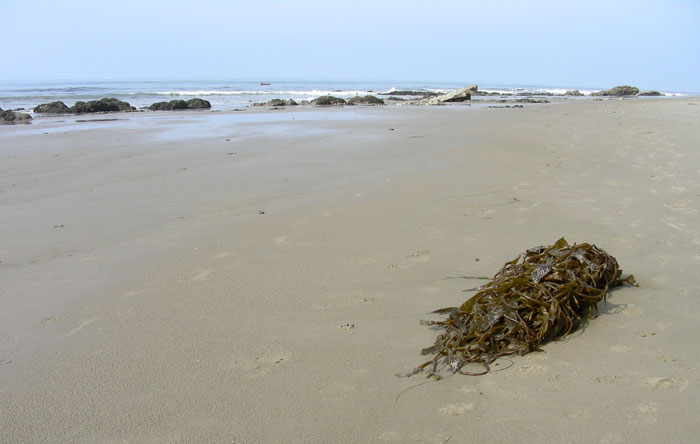
No seaweeds live on a sandy beach because most seaweeds need a solid attachment site and the constantly shifting sand does not provide this. Pieces of drifting seaweed often wash ashore however. High tide waves tend to pile up this drifting seaweed along the berm crest. These beach cast seaweed piles are often full of life. (GA image) |
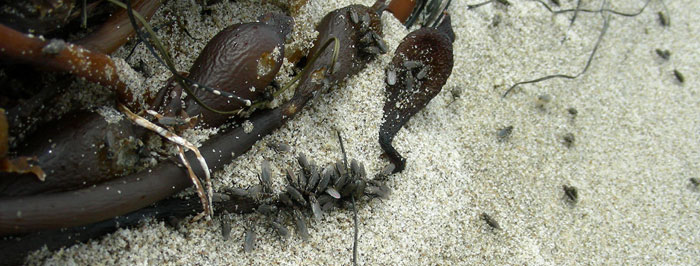


Kelp flies often cover seaweed cast upon the beach. If you walk up to a pile of drift seaweed there may be a swarm of kelp flies that fly off to another seaweed pile. These flies are attracted to the rotting seaweed and are feeding on it. They are a different species than the common house fly. Some people find them bothersome at the beach because they tend to linger on you longer than the average fly. These kelp flies, Coelopa vanduzeei, prefer bladder kelp, Macrocystis pyrifera, where they lay their eggs and rest. (GA images) |

Tiny red mites may be found in beach cast seaweed piles. The tiny, red mite (Neomolgus littoralis) is one of the more common of the predator/scavengers that may be in the dried and rotting seaweed piles left by the high tide along beaches. (GA image) |
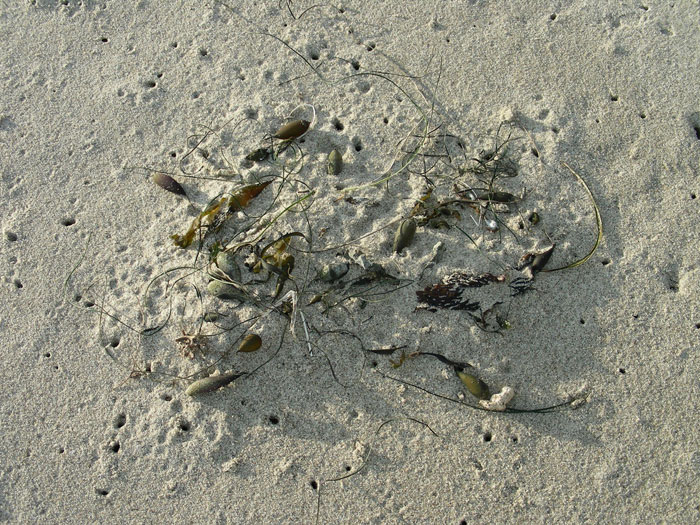
Activity around a seaweed pile is generally from the burrowing of a marine amphipod called a beach hopper. The beach hoppers dig around and under piles of rotting seaweed. This picture shows the activity of many beach hoppers around this pile of seaweed. (GA image) |

Beach hopper activity is seen as holes in the sand for digging (left) and for emerging (right). (GA image) |
| Beach entrance and exit holes are different. As they dig in the sand they plug up their entrance hole with a pile of sand (left) and when they exit they leave an open hole (right). (GA images) |

Beach hoppers burrow under seaweed to escape the dryness and heat of the day. They prefer the damp sand under the piles of rotting seaweed. This picture shows what you might see if you pulled up a pile of rotting seaweed ... the beach hoppers will jump (hop) this way and that. It is very easy to identify a beach hopper because it is the only species on the beach that will hop. At night many of the beach hoppers are out of the sand and hopping around the beaches in search of food. (GA image) |

Beach hoppers are crustaceans and are related to shrimp. Their bodies are laterally flattened (like shrimp) but they lack the carapace shell that covers the head and thorax region of a shrimp. Beach hoppers appear thin from a dorsal view due to their laterally flattened bodies and have segments from their head to the tip of their abdomen. (GA image) |
| Hopping and digging in the sand require specialized legs as seen in these views of the beach hopper's segmented body. The hoppers dig head first, inserting their antennae in the sand (left). As they dig their abdomen is the last part seen (right) before the hopper plugs up its hole. Beach hoppers are in the crustacean group whose members are called amphipods. The beach hoppers found on the sandy beaches of Santa Barbara belong to the genus Orchestia or Orchestoidea. Beach hoppers are sometimes called 'sand fleas' but they are not fleas (nor are they even insects) and are not able to bite humans. (GA images) |
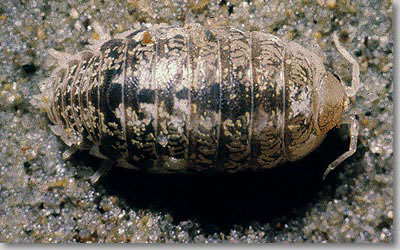 | Beach pillbugs are related to the pillbugs and sowbugs that are commonly found in terrestrial environments. These pillbugs look similar to the beach hoppers and are also related to shrimp, however they are dorso-ventrally flattened (flattened top to bottom) rather than laterally flattened and they do not hop. The beach pillbug can not roll up into a ball as some of the terrestrial pillbugs can. These beach pillbugs belong to a crustacean group the members of which are called isopods. (Image, with permission, from Western Marine Lab) |
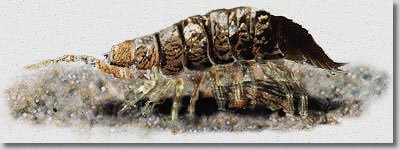 | Beach pillbugs appear flat when viewed from the side. They are scavengers and will eat whatever they can find. (LJF image) |
Most of the beach pillbugs dig in the sand just seaward of the berm crest and are not bothered by the waves or dryness at low tide because of their tough exoskeleton (outer "shell"). If food is not plentiful they have been known to bite the ankles of people wading in this high tide area but this is not common nor are they poisonous. The most common beach pillbug found on Santa Barbara beaches is Tylos punctatus. |
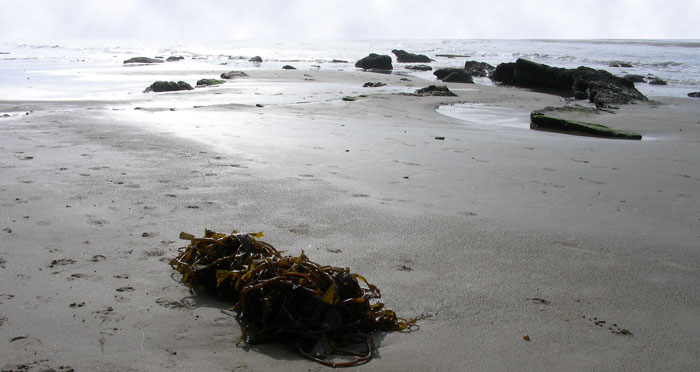
The mid tide beach may show an interesting band between the beach cast seaweed piles and a low tide. This is the habitat for a marine worm called the blood worm. Notice this band along the beach (parallel to the water) that has a different surface texture in the image above. This texture is shown close up in the image below. (GA image) |

Blood worms leave many surface holes in the sandy beach if the tide has been low for some time. (GA image) |
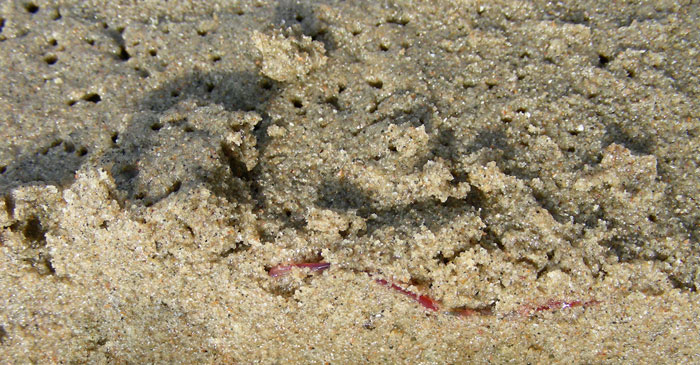
Blood worms are one of the most abundant sandy beach animals. These blood worms may occur in tremendous numbers in the mid intertidal area of a sandy beach. They are called blood worms because of the red color of their bodies. Their bodies stretch through the moist sand sometimes up to a foot long. They can be found up to about eight inches in depth. Below eight inches or so there is not enough oxygen in the moist sand for them to live. (GA image) |
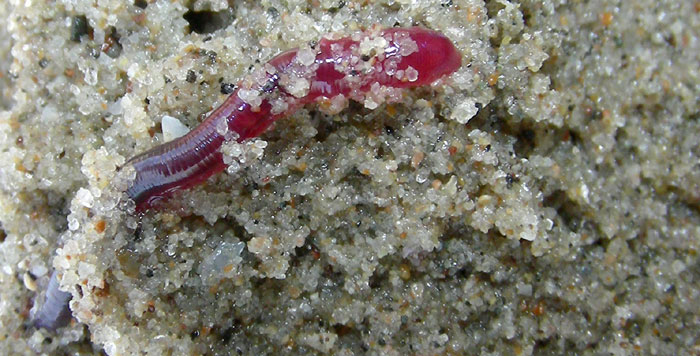
These blood worms are segmented worms in the genus Euzonus. There are several other segmented worms that are given the common name 'blood worm' because they can bite and make people bleed, however the sandy beach blood worm can not bite at all and is harmless to humans. Blood worms function on the sandy beach much like the earth worms do on land — they ingest the sediments (sand for the blood worms) and digest the organic material found between the sand grains. This type of feeding is called deposit feeding and results in a type of "cleaning" of the sediments. Between the sand grains in the mid intertidal area of most sandy beaches are numerous microscopic species that live in the tiny spaces. These species are collectively referred to as interstitial fauna (meiofauna) and are the primary food source for the blood worms. (GA image) |
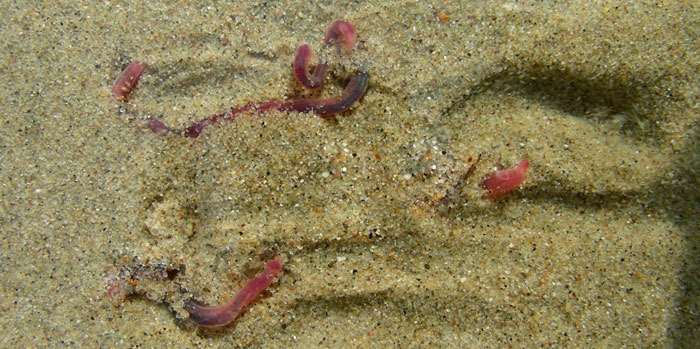
The color of blood worms is variable but they all have a red hue. These blood worms have washed free from the sand and show a variation in color from lighter pink/red areas to darker black/red areas. These variations are caused by the color of the sand grains ingested by the blood worm – darker sand grains make the blood worms appear a dark black/red and lighter sand grains make the blood worms appear a pink/red color. When removed from the sand the worms shrink to about 2-4 inches. These worms will immediately start digging back under the sand or the next tide will take them away. (GA image) |
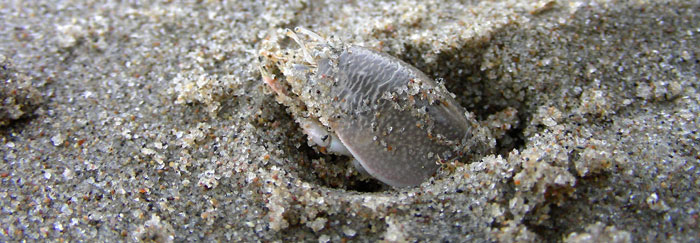
Sand crabs are well known inhabitants of sandy beaches in California. They are well known because they are constantly in motion – burying and reburying themselves while they reposition themselves in the wet sand along the edge of the wave wash area. Because of this behavior they are commonly seen along sandy beaches and picked up by children. The crab in this image is in the moist sand just above where the waves are washing along the shoreline. It is trying to bury itself in the sand backwards but the sand is so dry it is having trouble. Its eyes are held up during this digging but its antennae are tucked away. (GA image) |

Sand crabs extend their antennae above the sand in the shallow wave wash area to feed. The antennae are used for straining plankton from the water. Feeding with antennae is an unusual behavior for crustaceans (who usually use claws to rip and tear their food apart) who are generally considered scavengers. So, the sand crab is one of the few crustaceans considered a filter feeder. The image above shows a sand crab in the water with its antennae stretched out. The 'hairy' bristles on the long antennae are used to strain the plankton from the water. (GA image) |
The sand crab digs into the sand backwards so that its head and antennae are at the surface. This is so that it can extend its antennae into the water, above the sand, to feed. When sand crabs are feeding in the shallow wave wash area of the shoreline their extended antennae often make a disturbance that looks like a "V" (in the water) as the wave washes back down the foreshore. It is hard to see the antennae but you can tell when the sand crabs are feeding by this distinctive "V" patterning of the returning water. (GA images)

Sand crabs, Emerita analoga, molt to grow. This means that they shed their shell, leave the old shell behind, puff up their body with water and secrete a new shell on the puffed up body. The new shell is larger than the old shell and gives them room to grow into their new shell. Adults often molt about once per year. The image above is of a sand crab 'molt' - the old shell. It is empty and has baked in the sun to make it a pink color. Its eye stalks and antennae are dried out but the shell covering that was around them is still there. (GA image) |

Sand crabs have a hard time digging in dry sand. This sand crab has left a trail where it was digging out from under the sand. It emerged and flipped over. Unable to right itself, this poor sand crab would have been food for the shore birds if left upside down and unprotected. It was returned to the water after this picture was taken. When sand crabs have had enough to eat they no longer feed and may burrow deeper in the sand. This will put them at whatever tidal level they are at when feeding. This sand crab had probably been feeding at high tide, dug in and then was emerging when the water was very low that day. It was far, far away from the water and the sand was just too dry for it to dig in. If you dig in the sand you may be able to find sand crabs throughout the intertidal sandy beach but those who are hungry will always be feeding along the edge of the water whether it is high tide or low tide - they follow the shallow wave wash area up and down the beach. (GA image) |

Baby sand crabs may leave tiny trails as they reposition themselves along the beach due to tidal changes. This tiny sand crab has left a tell-tale trail as it has been digging in and then moving on down the beach. Adult sand crabs are generally a good inch or more in length so this baby has several molts to go before it is an adult. In California it is not uncommon to find sand crabs the size of chicken eggs in the summer. (GA image) |
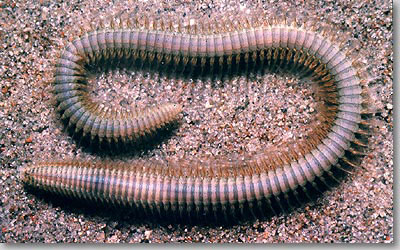 | Carnivorous segmented worms are rare, or uncommon, on sandy beaches. They feed on blood worms, young beach hoppers, young beach pillbugs, and young sand crabs as well as on each other. For this reason, there are usually very few carnivorous worms in comparison to the other sandy beach organisms that may number in the thousands of individuals per species on a typical sandy beach. (Image, with permission, from Western Marine Lab) |
There are several species of carnivorous worms on sandy beaches but they are very easy to distinguish from the more common blood worms simply by color – the blood worms have a red hue whereas the carnivorous worms have a beige or green hue. |
Bean clams, Donax gouldi, are common on some sandy beaches. Extending from between the two shells is the round fleshy siphon the clam uses to feed. (GA images) |
Bean clams occur on some California sandy beaches by the hundreds. They seem to have a 'feast or famine' existence - occurring in tremendous numbers for several years and then disappearing for a year or so, only to return again in astounding numbers. All bivalves (the group with all the clams, mussels, scallops and oysters) are filter feeders - filtering the microscopic plankton from the water for nutrition. The bean clams that are intertidal must do all their filtering when the tide is in and wait out the low tide. |
Beach cast jellyfish, Chrysaora colorata. (GA image) |
Beach cast drift may include broken pieces of seaweed as well as dead, or dying, animals. Any large planktonic form (like jellyfish) may become beach cast if the currents and winds push it onshore. In California there are years when jellyfish, and their relatives, are cast ashore by the hundreds. Other years the beaches may be bare. (GA image) |
Various species of birds use sandy beaches as either a feeding area or nesting area or just a place to rest. |
Sanderlings running up and down the wave wash area. (GA image) |
Black-bellied Plover. (GA image) |
Marbled Godwit (left and right) feeding. (GA images) |
Long-billed Curlew. (GA image) |
Western Gulls are like other sea gulls, they will eat anything and are thus referred to as scavengers. (GA image) |
Sandy beaches may be difficult places for small creatures to exist although it is a wonderful place for people to enjoy the marine environment. |
|

